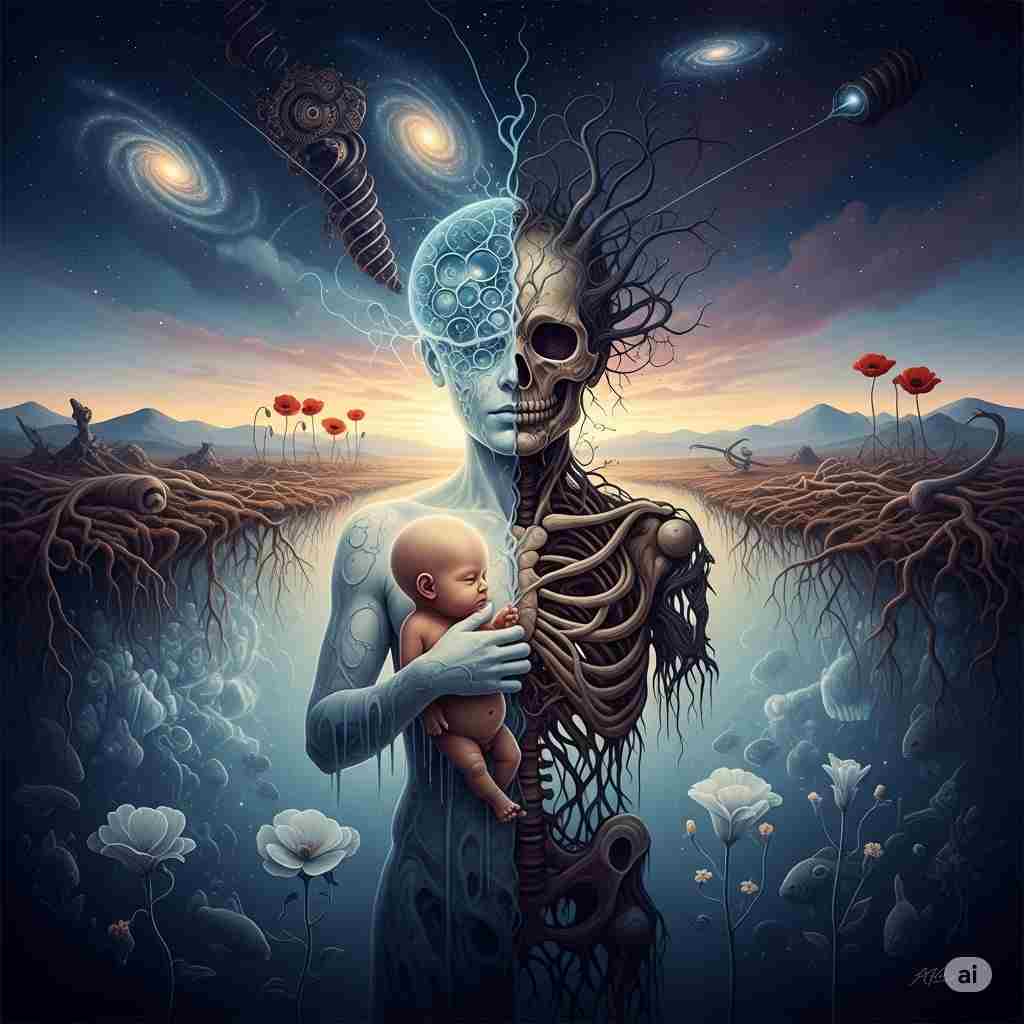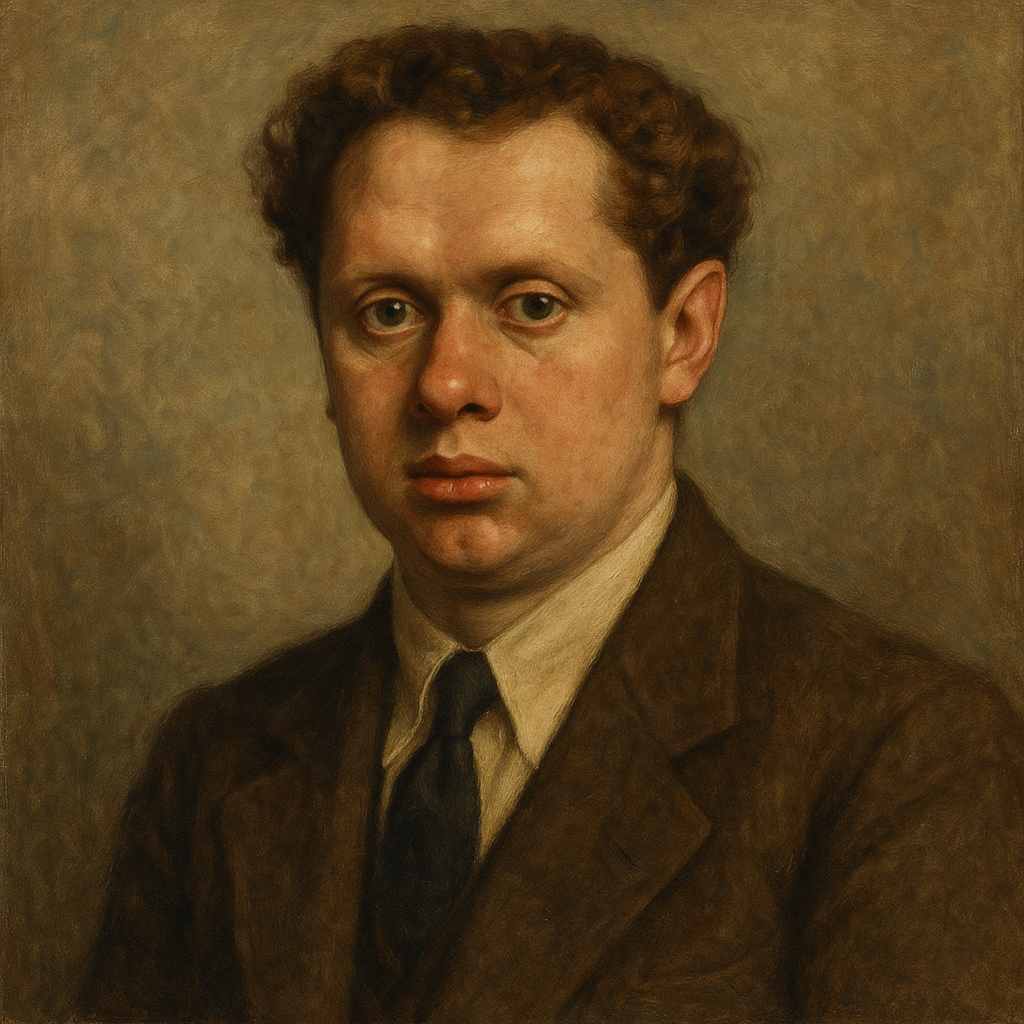When once the twilight locks no longer
Dylan Thomas
1914 to 1953

When once the twilight locks no longer
Locked in the long worm of my finger
Nor damned the sea that sped about my fist,
The mouth of time sucked, like a sponge,
The milky acid on each hinge,
And swallowed dry the waters of the breast.
When the galactic sea was sucked
And all the dry seabed unlocked,
I sent my creature scouting on the globe,
That globe itself of hair and bone
That, sewn to me by nerve and brain,
Had stringed my flask of matter to his rib.
My fuses timed to charge his heart,
He blew like powder to the light
And held a little sabbath with the sun,
But when the stars, assuming shape,
Drew in his eyes the straws of sleep,
He drowned his father’s magics in a dream.
All issue armoured, of the grave,
The redhaired cancer still alive,
The cataracted eyes that filmed their cloth;
Some dead undid their bushy jaws,
And bags of blood let out their flies ;
He had by heart the Christ-cross-row of death.
Sleep navigates the tides of time;
The dry Sargasso of the tomb
Gives up its dead to such a working sea;
And sleep rolls mute above the beds
Where fishes’ food is fed the shades
Who periscope through flowers to the sky.
When once the twilight screws were turned,
And mother milk was stiff as sand,
I sent my own ambassador to light;
By trick or chance he fell asleep
And conjured up a carcass shape
To rob me of my fluids in his heart.
Awake, my sleeper, to the sun,
A worker in the morning town,
And leave the poppied pickthank where he lies;
The fences of the light are down,
All but the briskest riders thrown,
And worlds hang on the trees.
Dylan Thomas's When once the twilight locks no longer
Dylan Thomas’s poetry is renowned for its dense imagery, musicality, and preoccupation with themes of life, death, and the cyclical nature of existence. “When once the twilight locks no longer” is a prime example of his work, encapsulating his fascination with bodily decay, cosmic forces, and the interplay between creation and destruction. This poem, though less frequently anthologized than some of his more famous pieces, is a rich tapestry of linguistic innovation and existential inquiry. Through an exploration of its historical and cultural context, literary devices, thematic concerns, and emotional resonance, this essay will illuminate the poem’s complexity and its place within Thomas’s oeuvre.
Historical and Cultural Context
To fully appreciate Thomas’s poem, one must situate it within the broader literary and philosophical movements of the early 20th century. Born in 1914, Thomas came of age during a period of immense upheaval—World War I had reshaped Europe’s psyche, and the rise of modernism had dismantled traditional poetic forms. Thomas’s work, however, resists easy classification. While he shares the modernist fascination with fragmentation and interiority, his poetry is deeply rooted in Romantic and even metaphysical traditions, with a strong emphasis on the visceral and the organic.
The 1930s and 1940s, when Thomas was most active, saw the rise of Surrealism and psychoanalytic thought, both of which left an imprint on his writing. The poem’s surreal imagery—such as “the long worm of my finger” and “the dry Sargasso of the tomb”—reflects an interest in the subconscious and the irrational. At the same time, Thomas’s Welsh heritage infuses his work with a bardic quality, a sense of incantation and myth-making. The poem’s preoccupation with bodily dissolution and cosmic forces aligns with Celtic traditions that view life and death as part of an eternal cycle.
Literary Devices and Imagery
Thomas’s poetry is characterized by its lush, often grotesque imagery, and this poem is no exception. The opening lines—
When once the twilight locks no longer
Locked in the long worm of my finger
—immediately establish a sense of bodily decay and transformation. The “long worm” suggests both the physical (a finger decomposing) and the metaphorical (time as a consuming force). The verb “locked” implies a previous state of containment that has now been undone, introducing the theme of dissolution.
The poem is rife with paradoxes and startling juxtapositions. The “milky acid” on the hinges of existence (perhaps the joints of the body or the mechanisms of time) is both nurturing and corrosive, embodying Thomas’s frequent conflation of creation and destruction. The “galactic sea” being “sucked” dry evokes an apocalyptic image, yet this desiccation leads to new life—the speaker’s “creature” being sent forth.
One of the most striking devices is Thomas’s use of personification and animism. Time has a “mouth” that “sucked, like a sponge,” while sleep “navigates the tides of time.” These images suggest a universe in which abstract concepts are living, almost vampiric forces. The line “He had by heart the Christ-cross-row of death” is particularly rich, blending religious symbolism (the cross, the alphabet of mortality) with the inevitability of decay.
Themes: Creation, Decay, and Cosmic Cycles
At its core, the poem grapples with the tension between life and death, creation and dissolution. The speaker describes sending forth a “creature”—perhaps a child, a poem, or a spiritual emanation—only for it to succumb to sleep and death. The imagery of fluids—milk, water, blood—underscores the poem’s concern with vitality and its loss. The “fluids in his heart” being “robbed” suggest a theft of essence, a vampiric transfer of life force.
The poem also engages with the idea of resurrection, though in a distinctly non-Christian manner. The lines—
The dry Sargasso of the tomb
Gives up its dead to such a working sea
—evoke a cyclical return, where the dead are not gloriously reborn but rather reintegrated into the natural world. The “fishes’ food” feeding the “shades” reinforces this ecological view of death as part of an endless metabolic process.
Comparative Analysis: Thomas and the Romantics
Thomas’s work often invites comparison with the Romantics, particularly William Blake and Percy Bysshe Shelley, who similarly explored visionary states and the dissolution of the self. Like Blake, Thomas employs dense, symbolic imagery that resists straightforward interpretation. The “creature” in the poem recalls Blake’s mythological figures, beings that exist simultaneously as psychological and cosmic entities.
Shelley’s “Ozymandias” comes to mind in the depiction of decay, though Thomas’s approach is more visceral than Shelley’s ironic monumentalism. Where Shelley’s ruins are silent and distant, Thomas’s decay is immediate, almost tactile—rotting flesh, bursting “bags of blood,” and “cataracted eyes.” This difference highlights Thomas’s modernist sensibility, his willingness to confront the grotesque in ways that the Romantics often aestheticized.
Biographical and Philosophical Undercurrents
Thomas’s personal struggles—with alcoholism, mortality, and artistic ambition—permeate his work. The poem’s preoccupation with fluids (milk, blood, seawater) may reflect his own fraught relationship with the body, both as a source of pleasure and a vessel of decay. The “redhaired cancer” could be read as a premonition of his father’s illness (D. J. Thomas died of cancer) or a metaphor for the consuming nature of time.
Philosophically, the poem aligns with existentialist thought, particularly the idea of life as an absurd, cyclical struggle. There is no transcendence in the traditional sense—only an endless exchange of energies, where the dead feed the living, and creation is inseparable from destruction. The final lines—
The fences of the light are down,
All but the briskest riders thrown,
And worlds hang on the trees.
—suggest a collapse of boundaries, a cosmic free-for-all where only the most vital (“the briskest riders”) endure. The image of worlds hanging on trees is both apocalyptic and strangely fertile, reinforcing the poem’s central paradox: that endings are also beginnings.
Emotional Impact and Conclusion
What makes Thomas’s poem so compelling is its emotional rawness beneath the linguistic pyrotechnics. The speaker’s tone is one of weary inevitability, as though observing the unraveling of life with both horror and resignation. The final invocation—
Awake, my sleeper, to the sun,
A worker in the morning town
—carries a faint hope, a call to rise from the “poppied pickthank” (a deceitful, opium-like slumber) and engage with the world. Yet this awakening is undercut by the knowledge that all must eventually return to the “dry Sargasso of the tomb.”
In conclusion, “When once the twilight locks no longer” is a masterful exploration of mortality, creation, and cosmic cycles. Through its dense imagery, paradoxical language, and existential themes, the poem captures Thomas’s unique vision—one that is at once terrifying and strangely beautiful. It stands as a testament to poetry’s power to confront the most profound mysteries of existence, not with answers, but with a relentless, luminous questioning.
This text was generated by AI and is for reference only. Learn more
Want to join the discussion? Reopen or create a unique username to comment. No personal details required!



Comments
No comments yet. Be the first to comment!